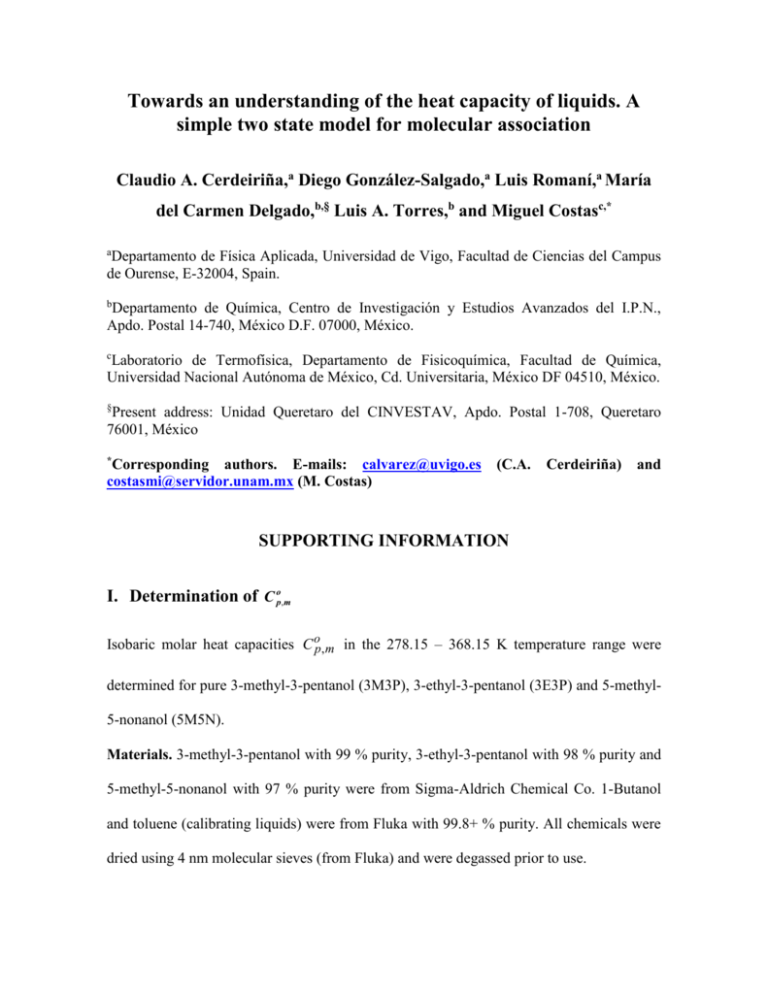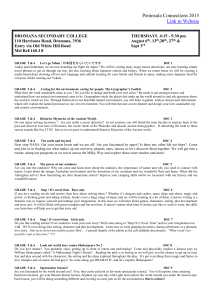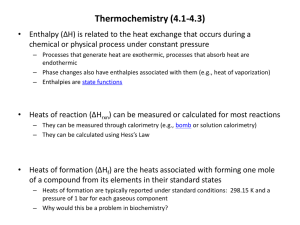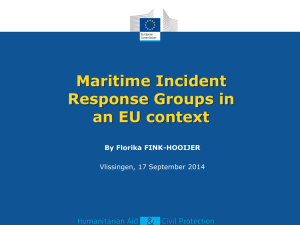EPAPS MS 508414JCP
advertisement

Towards an understanding of the heat capacity of liquids. A simple two state model for molecular association Claudio A. Cerdeiriña,a Diego González-Salgado,a Luis Romaní,a María del Carmen Delgado,b,§ Luis A. Torres,b and Miguel Costasc,* a Departamento de Física Aplicada, Universidad de Vigo, Facultad de Ciencias del Campus de Ourense, E-32004, Spain. b Departamento de Química, Centro de Investigación y Estudios Avanzados del I.P.N., Apdo. Postal 14-740, México D.F. 07000, México. c Laboratorio de Termofísica, Departamento de Fisicoquímica, Facultad de Química, Universidad Nacional Autónoma de México, Cd. Universitaria, México DF 04510, México. § Present address: Unidad Queretaro del CINVESTAV, Apdo. Postal 1-708, Queretaro 76001, México *Corresponding authors. E-mails: calvarez@uvigo.es costasmi@servidor.unam.mx (M. Costas) (C.A. Cerdeiriña) and SUPPORTING INFORMATION I. Determination of C op,m Isobaric molar heat capacities C op, m in the 278.15 – 368.15 K temperature range were determined for pure 3-methyl-3-pentanol (3M3P), 3-ethyl-3-pentanol (3E3P) and 5-methyl5-nonanol (5M5N). Materials. 3-methyl-3-pentanol with 99 % purity, 3-ethyl-3-pentanol with 98 % purity and 5-methyl-5-nonanol with 97 % purity were from Sigma-Aldrich Chemical Co. 1-Butanol and toluene (calibrating liquids) were from Fluka with 99.8+ % purity. All chemicals were dried using 4 nm molecular sieves (from Fluka) and were degassed prior to use. Procedures. Heat capacities per unit volume were measured with a differential scanning calorimeter Micro DSC II from Setaram, that has been described in detail in ref S1. The measurements were performed using the scanning method (scanning rate of 0.25 K min–1). The calorimeter was calibrated employing toluene and 1-butanol, whose heat capacities were taken from ref S2. Using this calorimeter, high sensitivity and optimum accuracy are reached when the working and reference cells are filled with liquids of similar heat capacities per unit volume. For this reason, the reference cell was filled with 1-butanol during the measurements. The heat capacities per unit volume were transformed into molar heat capacities using pure component densities. These densities were measured every 5 degrees using an Anton-Paar vibrating tube densimeter (model DSA–48) calibrated with water and n-octane as standard fluids. With this procedure, the uncertainty is less than 1 x 10-4 g cm-3. Cubic splines were used to fit the measured densities, so that the isobaric molar heat capacities can be calculated at any temperature within the working temperature interval. The errors associated with the determination of the densities and with the representation of these densities by cubic splines, do not affect significantly the repeatability and uncertainty of C op, m that are estimated to be 0.02 and 0.2 J K-1 mol-1, respectively. Results. Table S1 shows the pure alcohol heat capacities, C op, m , measured in this work with a step of 5 K. The data have been correlated using polynomials of the form n C po ,m /(J·K 1 ·mol 1 ) Bi T i (S1) i 0 The Bi coefficients were obtained by the least squares method and are given in Table S2, together with the standard deviations of the fits. Figure S1 shows that for the two sterically 2 hindered alcohols 3M3P and 3E3P C op, m (T) go through a maximum. To our knowledge, this is the first report of this behavior for pure liquids at atmospheric pressure. In order to verify that the maxima in Figure S1 are not an artifact, we performed two tests, namely: (1) We measured C op, m (T) for 3M3P using another DSC calorimeter (Perkin-Elmer DSC7), the results being given in Table S1 and displayed in Figure S1. In this measurement, special reusable gold plated stainless steel high pressure cells and gold plated copper seals were used. The cells and their content were weighted before and after the scanning and no mass loss was detected. The calorimeter was calibrated with Indium for the temperatureS3 and power compensation scales. Diphenyl ether was used as the standard reference material, as recommended by the NIST.S4 The heat capacities of 3M3P displayed in Figure S1 are the average values from five scans, performed over two independent samples. Both sets of measurements i.e. those from the Micro DSC II-Setaram and those from the PerkinElmer DSC-7 coincide (less than 1 % deviation) up to 325 K; at higher temperatures, the deviations are larger but always less than 1.5 %. Despite these small deviations, it is clear that the measurements with the second calorimeter confirmed the maximum in C op, m (T). (2) We evaluated the reproducibility of the measurements with de Micro DSC II calorimeter. The results for two independent runs for 3E3P are given in Table S1. The differences between the heat capacity values measured in each run are larger at higher temperatures but they do not exceed 0.1 %. Hence, the reproducibility can be considered very good. 3 In view of the results of these two tests and the fact that previous C op, m (T) measurementsS1 for other liquids have shown excellent agreement with those reported in the literature, we are confident that the C op, m (T) values in Table S1 and Figure S1 are reliable. II. Computation of H–Bond Energies Hydrogen bond energies for some alcohols and thiols have been estimated using quantum mechanics MP2 ab initio calculationsS5 These calculations were performed using the Gaussian 94 program with a 6-31G* basis set. The H–bond energies were obtained as the difference between the monomer A and the dimer Ai energies. The starting geometries for the monomers and dimers were those where all the carbon atoms in the hydrocarbon chains were in trans conformation. The local minimum character of the energies in the optimized dispositions was ensured using the harmonic vibration frequencies calculation. Corrections for the basis set superposition errorS6 (BSSE) constituted the final step in the calculation of = A – Ai, whose values are reported in Table S3. References [S1] C.A. Cerdeiriña, J.A. Miguez, E. Carballo, C.A. Tovar, E. de la Puente, and L. Romaní, Thermochimica Acta, 347, 37 (2000). [S2] M. Zabransky, V. Ruzicka, and E.S. Domalski, E.S., J. Phys. Chem. Ref. Data, 30(5), 1199 (2001). [S3] H.K. Cammenga, W. Eysel, E. Gmelin, W. Hemminger, and G.W.H. Höhne, Thermochimica Acta, 219, 333 (1993). [S4] D.C. Ginnings, and G.T. Furukawa, J. Res. Natl, Bur. Stand., 75, 522 (1953). [S5] A. Szabo, and N.S. Ostlund, Modern Quantum Chemistry (McGraw Hill, New York, 1990). [S6] P. Hobza, and R. Zahradnik, Chem. Rev., 88, 871 (1988). 4 Table S1. Isobaric Molar Heat Capacities C op, m (T) for Pure Sterically Hindered Alcohols T/K C op, m (T) / J·K–1·mol–1 3-methyl-3-pentanol 278.15 283.15 288.15 293.15 298.15 303.15 308.15 313.15 318.15 323.15 328.15 333.15 338.15 343.15 348.15 353.15 358.15 363.15 368.15 373.15 a 3-ethyl-3-pentanol 5-methyl-5-nonanol DSC IIa DSC-7b DSC IIa DSC IIa run 1a run 2a DSC IIa 266.34 274.33 282.21 289.77 296.93 303.56 309.57 314.77 319.25 322.85 325.75 327.97 329.50 330.40 331.13 331.01 330.66 329.99 329.15 327.54 337.27 346.26 353.99 360.59 365.80 369.56 371.94 373.16 373.21 372.43 371.07 369.31 367.16 364.98 362.62 360.17 357.69 355.21 351.19 358.33 365.72 373.23 380.98 388.86 396.73 404.60 412.41 420.04 427.50 434.79 441.96 448.84 455.74 462.01 468.01 473.65 478.90 281.30 290.09 296.88 304.23 310.30 316.04 321.42 325.55 329.05 331.33 333.54 334.63 335.23 335.69 335.48 335.06 333.21 332.18 327.50 337.21 346.15 353.95 360.48 365.75 369.45 371.82 373.01 373.06 372.34 370.98 369.22 367.05 365.00 362.69 360.28 357.90 355.47 Measured with the Setaram Micro DSC II. bMeasured with the Perkin–Elmer DSC-7. 5 Table S2. Coefficients Bi of Eq. (S1) and Standard Deviations a 3M3P 3M3Pb 3E3Prun1a 3E3Prun2a 5M5Na a B0 B1 B2 B3 B4 11976.7 7320.8 1034.66 863.313 1396.87 –157.486 –98.9817 –36.6228 –34.5708 –12.9095 0.771238 0.495048 0.284904 0.275828 0.0471173 –1.63673E-3 –1.05682E-3 –7.89405E–4 –7.71894E–4 –5.11339E–5 1.27764E–6 8.21411E–7 7.39175E–7 7.26794E–7 0.2 0.3 0.4 0.4 0.1 Measured with the Setaram Micro DSC II. bMeasured with the Perkin–Elmer DSC-7. 340 (b) (a) 380 300 350 -1 / J K mol 360 310 o p,m 320 C C o p,m -1 / J K mol -1 370 -1 330 290 340 280 330 270 260 320 280 300 320 340 360 380 280 300 320 340 360 380 T/K T/K Figure S1. Isobaric molar heat capacities C op, m measured in this work for (a) 3-methyl-3pentanol using the Setaram Micro DSC II () and the Perkin-Elmer DSC-7 () and for (b) 3-ethyl-3-pentanol (). 6 Table S3. Hydrogen bond energies for some alcohols and thiols, from quantum mechanics MP2 ab initio calculations Substance / J·mol–1 Methanol Ethanol 1-Propanol 1-Butanol 1-Pentanol 19409 21227 21546 21825 21904 2-Propanol 2-Butanol 2-Methyl-1-Propanol 2-Methyl-2-Propanol 22151 21682 22090 22308 Metanethiol Etanethiol 1-Propanethiol 5140 5217 5460 7





